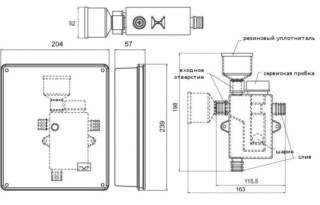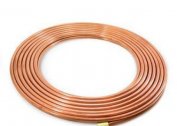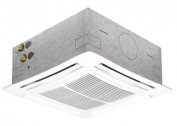During the operation of the air conditioner, condensation forms. To collect moisture, the design of the indoor unit provides a special tray. Condensate drainage is carried out by a drainage hose. According to the rules, climatic equipment for water discharge must be connected to the sewer system. A trap with a water trap prevents unpleasant odors from entering the apartment.
Device purpose
 Bringing the drain hose out through the hole in the wall is the easiest way to drain the condensate. A flexible tube with a length of 80 cm is used to drain the moisture formed. A simple and affordable option has its drawbacks: it is prohibited by SNiP, drops fall on passers-by, in winter, the drainage pipe freezes. In a private house, erosion of the blind areas is added. The best solution is to connect the air conditioner to the sewer. An indispensable condition for proper installation is the installation of a siphon with an odor-locking device. It allows liquid to pass in one direction and prevents the entry of not only odor, but also hazardous gases into the room.
Bringing the drain hose out through the hole in the wall is the easiest way to drain the condensate. A flexible tube with a length of 80 cm is used to drain the moisture formed. A simple and affordable option has its drawbacks: it is prohibited by SNiP, drops fall on passers-by, in winter, the drainage pipe freezes. In a private house, erosion of the blind areas is added. The best solution is to connect the air conditioner to the sewer. An indispensable condition for proper installation is the installation of a siphon with an odor-locking device. It allows liquid to pass in one direction and prevents the entry of not only odor, but also hazardous gases into the room.
Siphon principle
A conventional trap with a water trap is U-shaped. In the elbow connecting the inlet and outlet, there remains water, which is a barrier to the exit of sewer odors. When using plumbing fixtures, the water in the hydraulic lock often changes, the level does not have time to decrease. In the case of air conditioning, the flow of moisture is uneven, if the equipment does not work, then the condensate does not drain. The water lock dries, in the absence of a water barrier, gases penetrate the room.
To prevent an unpleasant situation, a check valve helps to drain the air conditioner. The device blocks air and sewage drains, and condensate freely passes. As a locking mechanism, an ABS ball or a spring membrane is used.
When the unit is filled with water, the float rises, opening the outlet to the sewer. After leaving the liquid under its own weight falls, blocking the hole.
Types of siphons
Devices are classified according to two signs: design and method of removing moisture.
Arc shaped model with a water seal
The standard version is bulky in size. The height of the water lock should be between 140-320 mm. The nozzles are made transparent for visual inspection. Outlet diameter 40 mm. It is possible to connect a washing machine to refill the water lock. The model is recommended for high pressure or vacuum in the drainage pipe. Among the disadvantages of the unit: large size, favorable environment for the development of bacteria, the probability of drying out.
Water trap design with odor trap
Compact version for concealed and open installation. The unit has a water shutter and an odor-locking mechanism in the form of an ABS ball. When the level of the hydraulic lock drops, the shut-off valve closes the branch pipe. The model is equipped with a cleaning - a camera for collecting dirt. Siphon entrance vertical or horizontal, pipe DN32. Horizontal outlet DN40.
Flush Mount System
The siphon assembly for draining the air conditioner into the sewer is hidden in a plastic box. The unit body is installed in the wall. The type of placement is vertical, the height of the hydraulic lock is 50 mm. Case size 100x100x60 mm. Two tubes are brought to the box - the inlet pipe and the outlet into the sewer.It is possible to connect drainage hoses of three diameters: 20, 26, 32 mm. Inside the case is a transparent cassette with a water shutter and odor-locking device. The valve opens when condensate passes and lowers when water flows out. The cartridge is replaceable, it is independently removed and cleaned of dirt.
The kit has a construction plug and a decorative cover with spring clips. When choosing the installation site, the requirement is taken into account - the minimum distance between the outlet pipe of the split system and the siphon is 2 m. To service the unit, it is enough to remove the decorative cover.
Dry aggregate
Using a water trap is a simple and cheap solution to the problem of locking off unpleasant sewer odors. Without regular renewal of the water barrier, its benefits disappear.
Dry air lock for the air conditioner is a design with a membrane, a swing valve or a tube that performs the function of a check valve.
The most common option is an elastic tube with molecular memory. In the normal state, it is closed and seals the sewer gases. During the passage of water, the tube opens, then returns to its original shape. Dry shutter benefits:
- compact size;
- due to the smooth surface of the membrane or tube, the device does not clog;
- serves as a reliable obstacle to the spread of smell from the sewer;
- does not freeze in winter;
- lack of knees provides high throughput;
- allow vertical and horizontal installation.
Dry siphon is used not only for drainage of air conditioners, it is installed under baths and sinks in the country.
The second classification item is the condensate discharge method:
- vertical release;
- horizontal release;
- combined option.
How to choose a siphon to drain condensate from an air conditioner
Siphons installed for condensate drainage vary in size and design. When choosing a model, several criteria are taken into account:
- Outlet diameter for condensate drain. The size of the drain hose must match the inlet of the siphon.
- Estimated free space for mounting the device. Dimensions of the model may not fit in the designated area.
- For built-in siphons, the depth of the mounting niche in which the unit is installed is estimated.
- The throughput of the unit should correspond to the amount of condensate. The characteristics of the devices indicate the necessary information. The low-capacity siphon is not suitable for air conditioners with large condensate volumes.
- Rubber seals at the inlet and outlet of the unit provide a tight seal. When a siphon is placed in the sun, ultraviolet will quickly render them unusable. In such a situation, hidden installation is required.
Installation of a drainage system
A flexible hose is routed from the drain hole of the indoor unit of the air conditioner. To place it in the wall, a strob breaks through.
The line should not make sharp turns, they prevent a uniform drain of fluid. Assume an angle of 45 °.
To ensure condensate drainage by gravity, the hoses are laid with a slope of 1-2 cm per 1 m of length. Sagging hoses is not allowed.
Before entering the sewer, a siphon with a water trap is installed, which cuts off unpleasant odors. Installation is carried out using crimping nuts. The flow direction is marked on the unit body. The arrow helps determine entry and release. Connection to the sewer network is performed with a jet break. After installation, a system test is performed.
Major manufacturers
Hutterer & lechner
The leader in the production of siphons for air conditioning systems is the Austrian company Hutterer & Lechner (HL). Products are of high quality and simplicity of design. The technology of equipping the units with a water shutter and a locking ball valve prevents the appearance of unpleasant odors.The company offers siphons of various models:
- HL 136.2 - siphon with a water lock;
- HL 138 - embedded system;
- HL 136 N - unit with a water lock and a ball odor-blocking device.
Vecamo
The Italian company Vecamo offers a siphon for the air conditioner, which is mounted on the wall, providing free access to the inlet and outlet. The kit includes connectors designed for drainage hoses of various diameters. A transparent plastic case provides the ability to monitor the condition of the inside.
Mcalpine
McAlpine's MacValve Series self-closing drain valve or dry siphon is available in two installation sizes: 32 and 40 mm. A polymer tube is installed in a compact plastic case, which acts as an odor-locking device. Vertical installation is recommended, but horizontal installation is acceptable. In the first case, the throughput is 1.58-275 l / s, in the second lower - 0.7-1.7 l / s.
The design of siphons with a non-return valve for draining condensate into the sewer system is thought out by professionals. To make such a device alone will not work. The only option available is a simple design with a knee and a water barrier that can dry at any time.




